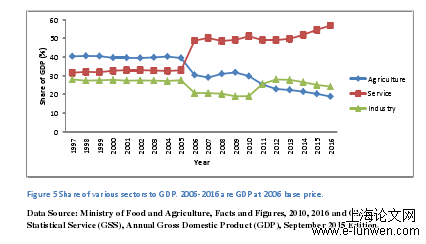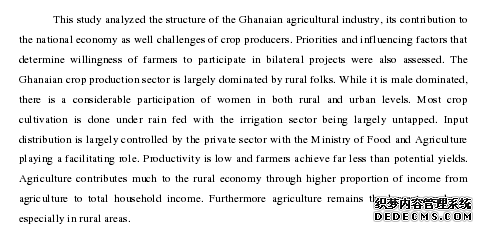1.1 Background
The world population is estimated to reach over 9 billion by 2050 and a search for strategy to feed this soaring global population, reduce poverty and enhance shared prosperity lies in a developed global agricultural sector [Food and Agriculture Organization (FAO), 2009],which has proven to be more effective in increasing income levels of poor people. There is very strong linkage between industrialization and agricultural development as it has been noticed that countries with high agricultural productivity growth and equal attention for its agricultural sector were successful in their industrialization drive while countries that practiced the reverse were ineffectual industrializers (Ludena, 2010). Agribusiness drive for several decades was the main growth path that propelled the development of the Brazilian economy which earned it an “emerging economy” status, hence the power of agribusiness in development cannot be downplayed (Scoones et al. 2016). In China, through accelerated agricultural development, rural poverty declined from 53 percent in 1981 to 8 percent in 2001(World Bank, 2007).
In Sub-Saharan Africa, agriculture serves as a major source of employment and income generation, since about two-thirds of the sub-continent?s population are found in rural areas and engaged in agriculture (Devèze, 2011). Furthermore, most African countries are mainly agrarian economies which imply that through agriculture, rural economies could participate invaluably in the development of the national economies in the continent (Losch, 2011). However, there is still much to be done in Africa in order for agriculture to lead the overall economic transition of the continent as had happened in the so called developed and emerging economies where agriculture served as a stage post for further development of other productive sectors such as manufacturing, industry and services (Losch, 2011).
....................
1.2 Justification
While moderate progress has been made over the years in agricultural growth in Ghana, it has however been highly erratic and heterogeneous. The agricultural sector in Ghana recorded an average growth of 2% between1991-1995 which rose to 5.6% in 2006 (Cervantes-Godoy and Dewbre 2010). However, there was a negative growth in 2007 (-1.7%) , while in 2008, 2009, 2010, 2011 and 2012 it grew by 7.4%, 7.2%, 5.3%, 0.8% and 2.6% respectively, indicating a highly erratic pattern of growth between the period 2008-2012 [Ministry of Food and Agriculture, Ghana, (MoFA), 2012]. Furthermore, growth experienced in the sector has largely been attributed to land expansion rather than productivity growth (Breisinger et al. 2008) while significant variations also exist in growth among various agro-ecological zones due to heterogeneity in agricultural structures. For sustainability of the sector, and for agriculture to lead in the whole economic transformation, a sustained growth is desired through increased productivity. The above uncertainty showed in the growth of the Ghanaian agricultural sector leaves several questions unanswered albeit there have been several interventions in the sector by government and through international development cooperation.
........................
CHAPTER TWO: LITERATURE REVIEW
2.1 History of Cooperation between China and Africa
2.1.1 Classical History of China-Africa Relations Chinese porcelains that were made during the Tang dynasty (614-907) were also found by archeologists in Kenyan villages and were believed to be brought to Kenya by Zheng He during his 15th century ocean voyages (New African Magazine, 2015). A 15th-century Chinese “Yongle Tongbao” coin which was a small disk of copper or brass and silver with a square hole in the center was found by Kenyan and Chinese archeologists at the north of Malindi, Kenya?s north coast which is believed to be carried by envoys of the emperor (New African Magazine, 2015). These are evidences that allude to the age old relationship which exists between China and the African continent. These classical relationships laid foundation for the furtherance of the modern synergy between China and Africa.
2.1.2 Modern account of China-Africa Relations
Contemporarily, the Sino-Africa relationship can be traced back to the late 1950s (Young & Neuhauser, 1969), where bilateral trade agreements were entered between China and Egypt, Algeria, Morocco, Somalia, Sudan and Guinea (Khan & Baye, 2008). The first diplomatic agreement was entered with Egypt in 1956; by early 1960s, 10 African countries had established similar relations and by the end of 1970, there was a widespread recognition of the Peoples? Republic of China (PRC) by African countries (Strauss, 2009). In the early 1960?s, China supported a number of African countries in anti-imperialist struggles and independence movements (Amanor & Chichava, 2016). In return, these African countries gave China their political support on the “one China” policy. In the year 1971, China regained its seat at the United Nations with the aid of 26 votes from African nations. This period (1950s-1970s) marks the first phase of contemporary Sino-Africa cooperation. In this period China extended aid to Africa in the form of agriculture, construction, etc (Amanor and Chichava, 2016). This was followed by a modified approach in the 1980s to 1990s and an accelerated engagement in the beginning of the 21st century (Chun, 2013). In the second stage, China modified its cooperation with a mixture of aid and investments.
..........................
2.2 Agricultural Cooperation between China and Africa
2.2.1 The trends of agricultural Cooperation between
China and Africa China?s involvement in African agriculture is almost half a century now and engagement patterns have evolved over time. The early phase of engagement (1950s-1970s) was largely impelled by a need for the new Chinese nation to build soft power and gain recognition on the global stage, thus initiated projects in Africa were characterized by bilateral agreements and donation-based aid (Buckley, 2013). In the mid-1980s China?s agricultural engagement in Africa saw a blend of aid and investment after a reform of China?s foreign policy by the then premier of the PRC, Deng Xiaoping (Hees, 2013). In the beginning of the 21st century, strong diplomatic and business ties were established with the institutionalization of FOCAC in 2000, which can be described as a fast track stage of Sino-African cooperation (Chun, 2013). This period saw a series of trade missions, state visits and a rising development cooperation program run from the Ministry of Commerce (MOFCOM) (Scoones et al., 2016). Agriculture has since taken center stage in the Sino-African discourse. In the 2006 FOCAC summit in Beijing, China resolved to accelerate agricultural investment in Africa (Sun, 2011) and announced the construction of Agricultural technology demonstration centers (ATDCs) across the continent as a flagship program. Furthermore, the Johannesburg Summit and the 6th Ministerial Conference of FOCAC which was held in Johannesburg in 2015 also came out with an action plan (2016-2018) with much focus on agricultural cooperation. In the action plan, eleven points were agreed on by both parties to boost agriculture and food security (FOCAC, 2015). As shown in Fig. 2, by 2010 a total of 221 agricultural cooperation projects were established by the Chinese government in Africa, with 35 demonstration farms, 47 technology stations, 47 irrigation and water conservation projects, 15 fisheries, 11 livestock projects and 66 other agricultural related projects (Smaller et al., 2012).

........................
CHAPTER THREE: MATERIALS AND METHODS ......................................... 20
3.1 Study Area description ....................................... 20
3.2 Sampling Procedure ........................................ 21
CHAPTER FOUR: RESULTS ...................................... 25
4.1 Analysis of Agricultural Industry in Ghana ............................... 25
4.1.1 Agricultural Structure in Ghana .................................. 25
4.1.2 Principal crops in Ghana ........................ 26
5.0 DISCUSSIONS ................................................... 42
5.1 Analysis of Ghanaian Agricultural Sector and current performance levels .......................................... 42
5.2 Analysis of Farmers’ Challenges and influencing factors of farmers’ willingness to participate in bilateral projects ..................... 42
5.0 DISCUSSIONS
5.1 Analysis of Ghanaian Agricultural Sector and current performance levels
Farming is mostly concentrated in the rural areas (Table 3) and predominantly on small holder basis with national average land size of less than 2 hectares per farmer [Ministry of Food and Agriculture Ghana, (2015)]. There is still vast land still uncultivated (53%) which is a potential to increase crop production in Ghana. However, crop cultivation in Ghana is predominantly rainfed with less than 5% of cultivated land being irrigation (Table 2). Development of the irrigation sector in the country is very low. Other studies even purge this figure at 2% (e.g. Namara et al., 2011). The concentration of farming in the rural areas and the considerable proportion of women in this sector (Table 3) holds a great opportunity to impact and accelerate the integration of the rural economy to overall national economic transformation. This can only be achieved if the current productivity levels are raised to meet or approach potential productivities. In table 5, it is evident that most farmers in Ghana achieve far lower yields compared to the potential yields. Various regions in Ghana have comparative advantages in terms of crop production. Inferring from data from MoFA, (MoFA, 2010, 2012, 2015, 2016), it is clear that the Brong-Ahafo and Northern regions have very high advantage in terms of food security crops such as maize, rice and cassava. The private sector is by far the major contributor to input supply to crop production in Ghana. The agricultural sector still remains the largest employer in Ghana despite a decline in proportion of contribution of agriculture to GDP in recent years.

.........................
6.0 Conclusion

reference(omitted)

